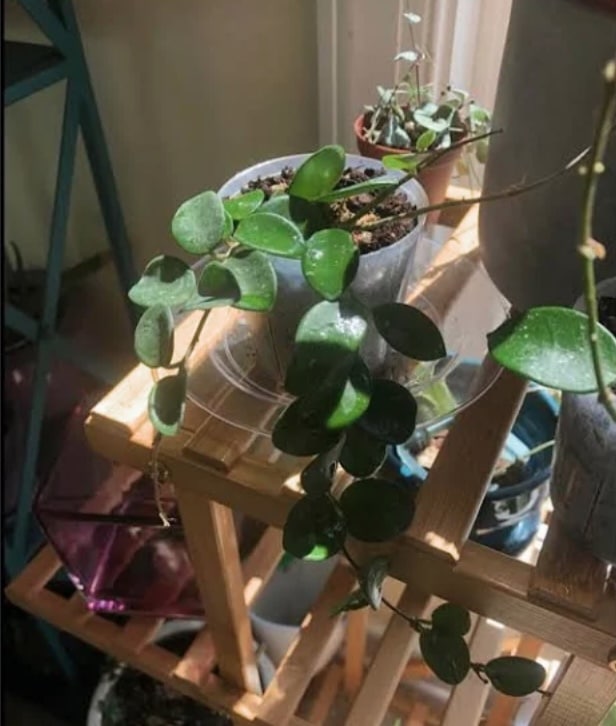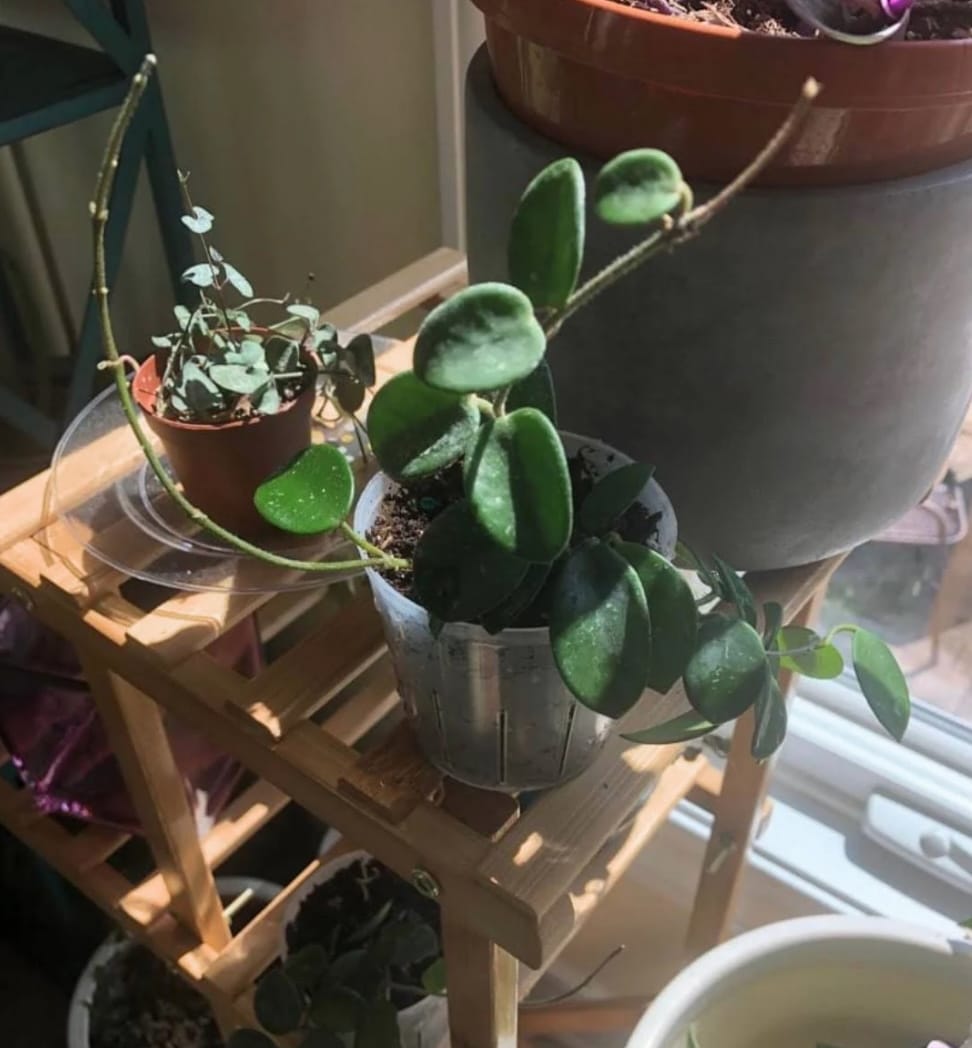The other names given to Hoya Mathilde are Hoya Mathilde Splash and Hoya Mathilde Variegata. This is all because of the specks of silver that are present on the leaves like splashes. This plant is cultivated by crossing Hoya Serpens and Hoya Carnosa. Thus you have to provide it with double the care.
The plant is an epiphyte which means it needs support to grow. It has round leaves and is small with some light speckling. If you carefully look, you will notice that the leaves’ undersides are a bit fuzzy. During the warm season, the plant produces clusters of white, fuzzy fragrant flowers with pink centers.
Hoya Mathilde Care

Let’s ponder on the ways you have to take care of the plant and its requirements:
SUNLIGHT
As we know the plant has green leaves with little specks of white. These plants can maintain their color when provided with indirect light. If not provided with ample sunlight it will start dropping. You should keep it 3 feet away from your window so that it can develop to its full potential. It appreciates both late afternoon and morning sunlight. Under such circumstances, it will bloom to its best capacity and grow to be a thing of beauty.
WATERING
The plant does not require a lot of water as it has succulent leaves. Thus when you are taking care of the plant staying on the dry side is better than adding more water leading to its over-watering. It has no problem with a little bit of dryness but is very sensitive to being over-watered.
During the warmer months be regular as the soil dries up quickly but during the cold months they don’t need that much water. The plants’ water needs are not as regular as the other plants.
PRUNING
We do not recommend pruning the spurs once the flowers fade away. This is one of the most imperative angles of pruning for Hoya Mathilde if you want it to keep on blossoming.
The reason behind this is that the nature of the spurs is perennial. In other words, it means that the new flowers will bloom from the very spurs again and again. Thus if you prune them away it will eliminate the growth of the flowers.
The plant as a whole also does not require any kind of pruning. You will just have to chop off the vines when they grow too much. That is all.
HUMIDITY
Humidity isn’t a colossal issue for the Hoya Mathilde because it can endure customary room humidity. The credit goes to its succulent-like leaves.
If you look carefully at the plant’s leaves, you’ll see that the leaves are fleshy and thick. The reason behind this is that they can store moisture in them. This permits them to face periods of low humidity and dryness. The ideal humidity range for Hoya Mathilde is 40% – 60%.
USDA CLIMATE ZONES
Outdoors the best suited USDA Hardiness Zones for Hoya Mathilde are Zones 11 and 10. The reason behind this is that the plant can survive in mildly cold conditions and won’t be too cold. Zones 11 and 12 experience very mild winters and have plenty of sunshine to help your plants develop to their fullest. Thus it would get all the conditions it requires to bloom to their fullest potential.
FERTILIZER
The plant does not need much feeding but it is obvious that it will benefit from extra nutrients. Thus it is quite vital to provide it with fertilizer especially during its growth period, which are the summer and spring seasons.This helps the plant in producing better and more leaves and it also grows well. You may use a liquid fertilizer that you should dilute to half of its strength. It should be used once every two weeks or once a month. You should start with the latter as it is better to see the plant react to the fertilizer.
Remember more quantity does not always mean that it is good for the plant. Extra of anything can be very harmful. Thus, keep your plant under observation.
SOIL TYPE
In order to permit the drainage of extra moisture after you are done watering the plant, it is very vital to plant it in the right soil.
The soil best suited for planting the Hoya Mathilde has to be lightweight, well-aerated and well-draining.
As mentioned earlier Hoya Mathilde its roots need room to breathe well. When in the wild these plants have a habit of hanging onto the nearby trees. There their roots have an abundance of air circulation. This is the main reason that planting this plant in well-aerated soil is very important. The better the drainage the faster the plant will be able to lose the excess moisture. In this manner, the roots don’t have to be overflowed with water.
PROPAGATION
The most common to propagate the plant is via stem cuttings. This is by far the most effective way to plant the Hoya Mathilde. You do not need any kind of special equipment to carry out this propagation. When propagating through stem cuttings, you should plant it in freshwater, soil or sphagnum moss.
Follow these steps for better propagation:
- Make an incision right above the node. This is the point of the emergence of the leaf
- For growing the roots from the cutting you can follow any of the given two methods
- Place the cutting of the plant in water till the time you see roots emerging from it. See that the length is 2 cm long, only after that transfer it into the soil.
- You can directly plant it into the soil and keep on watering once the soil dries up.
If you follow these steps you will be able to propagate the plant correctly ensuring the right growth.
CONCLUSION
Now you know how to take care of your Hayo Mathilde and all the things it requires to develop to its fullest. Keep all the things mentioned above when planting a Hayo Mathilda.
Related: Hoya Kerrii
